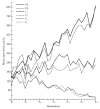Top 10 Replicated Findings From Behavioral Genetics
- PMID: 26817721
- PMCID: PMC4739500
- DOI: 10.1177/1745691615617439
Top 10 Replicated Findings From Behavioral Genetics
Abstract
In the context of current concerns about replication in psychological science, we describe 10 findings from behavioral genetic research that have replicated robustly. These are "big" findings, both in terms of effect size and potential impact on psychological science, such as linearly increasing heritability of intelligence from infancy (20%) through adulthood (60%). Four of our top 10 findings involve the environment, discoveries that could have been found only with genetically sensitive research designs. We also consider reasons specific to behavioral genetics that might explain why these findings replicate.
Keywords: DNA; cognitive abilities; heritability; personality; psychopathology.
© The Author(s) 2015.
Figures





Comment in
-
Weak Genetic Explanation 20 Years Later: Reply to Plomin et al. (2016).Perspect Psychol Sci. 2016 Jan;11(1):24-8. doi: 10.1177/1745691615617442. Perspect Psychol Sci. 2016. PMID: 26817722
-
Why Behavioral Genetics Matters: Comment on Plomin et al. (2016).Perspect Psychol Sci. 2016 Jan;11(1):29-30. doi: 10.1177/1745691615611932. Perspect Psychol Sci. 2016. PMID: 26817723 No abstract available.
References
-
- Avinun R, Knafo A. Parenting as a reaction evoked by children's genotype: A meta-analysis of children-as-twins studies. Personality and Social Psychology Review. 2014;18:87–102. doi: 10.1177/1088868313498308. - PubMed
-
- Bakker M, van Dijk A, Wicherts JM. The rules of the game called psychological science. Perspectives on Psychological Science. 2012;7:543–554. doi: 10.1177/1745691612459060. - PubMed
-
- Baltes PB, Reese HW, Lipsitt LP. Life-span developmental psychology. Annual Review of Psychology. 1980;31:65–110. doi: 10.1146/annurev.ps.31.020180.000433. - PubMed
-
- Bartels M, van den Oord EJ, Hudziak JJ, Rietveld MJ, Van Beijsterveldt CE, Boomsma DI. Genetic and environmental mechanisms underlying stability and change in problem behaviors at ages 3, 7, 10, and 12. Developmental Psychology. 2004;40:852–867. doi: 10.1037/0012-1649.40.5.852. - PubMed
Publication types
MeSH terms
Grants and funding
LinkOut - more resources
Full Text Sources
Other Literature Sources

